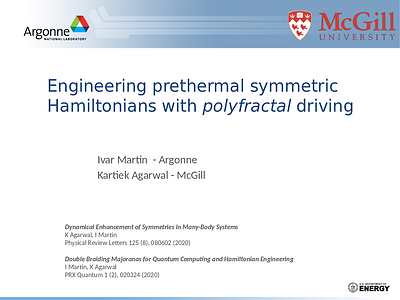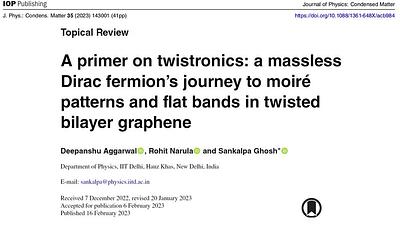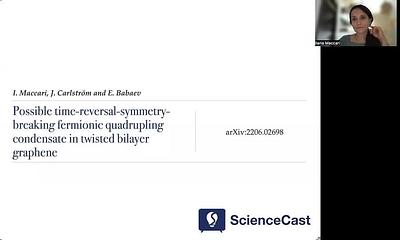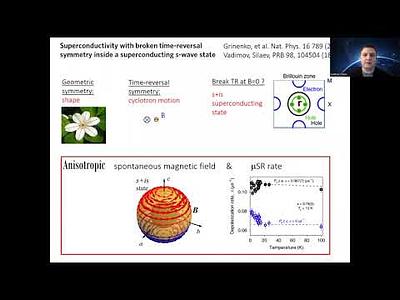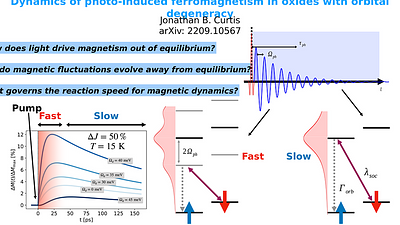Spin waves and high-frequency response in layered superconductors with helical magnetic structure
3upvotes
By: A. E. Koshelev
We evaluate the spin-wave spectrum and dynamic susceptibility in a layered superconductors with helical interlayer magnetic structure. We especially focus on the structure in which the moments rotate 90∘ from layer to layer realized in the iron pnictide RbEuFe4As4. The spin-wave spectrum in superconductors is strongly renormalized due to the long-range electromagnetic interactions between the oscillating magnetic moments. This leads to a stro... more
We evaluate the spin-wave spectrum and dynamic susceptibility in a layered superconductors with helical interlayer magnetic structure. We especially focus on the structure in which the moments rotate 90∘ from layer to layer realized in the iron pnictide RbEuFe4As4. The spin-wave spectrum in superconductors is strongly renormalized due to the long-range electromagnetic interactions between the oscillating magnetic moments. This leads to a strong enhancement of the frequency of the mode coupled with a uniform field and this enhancement exists only within a narrow range of the c-axis wave vectors of the order of the inverse London penetration depth. The key feature of materials like RbEuFe4As4 is that this uniform mode corresponds to the maximum frequency of the spin-wave spectrum with respect to the c-axis wave vector. As a consequence, the high-frequency surface resistance acquires a very distinct asymmetric feature spreading between the bare and renormalized frequencies. We also consider the excitation of spin waves with Josephson effect in a tunneling contact between helical-magnetic and conventional superconductors and study the interplay between the spin-wave features and geometrical cavity resonances in the current-voltage characteristics. less
By: A. E. Koshelev
We consider a clean layered magnetic superconductor in which a continuous magnetic transition takes place inside superconducting state and the exchange interaction between superconducting and magnetic subsystems is weak so that superconductivity is not destroyed at the magnetic transition. An example of such material is RbEuFe4As4. We investigate the suppression of the superconducting gap and superfluid density by correlated magnetic fluctuat... more
We consider a clean layered magnetic superconductor in which a continuous magnetic transition takes place inside superconducting state and the exchange interaction between superconducting and magnetic subsystems is weak so that superconductivity is not destroyed at the magnetic transition. An example of such material is RbEuFe4As4. We investigate the suppression of the superconducting gap and superfluid density by correlated magnetic fluctuations in the vicinity of the magnetic transition. The influence of nonuniform exchange field on superconducting parameters is sensitive to the relation between the magnetic correlation length, ξh, and superconducting coherence length ξs defining the 'scattering' (ξh<ξs) and 'smooth' (ξh>ξs) regimes. As a small uniform exchange field does not affect the superconducting gap and superfluid density at zero temperature, smoothening of the spatial variations of the exchange field reduces its effects on these parameters. We develop a quantitative description of this 'scattering-to-smooth' crossover for the case of quasi-two-dimensional magnetic fluctuations. Since the magnetic-scattering probability varies at the energy scale comparable with the gap, the quasiclassical approximation is not applicable in the crossover region and microscopic treatment is required. We find that the corrections to both the gap and superfluid density grow proportionally to ξh until it remains much smaller than ξs. When ξh exceeds ξs, both parameters have much weaker dependence on ξh. Moreover, the gap correction may decrease with increasing of ξh in the vicinity of the magnetic transition. We also find that the crossover is unexpectedly broad: the standard scattering approximation becomes sufficient only when ξh is substantially smaller than ξs. less
By: Ivar Martin, Kartiek Agarwal
We construct a dynamical decoupling protocol for accurately generating local and global symmetries in general many-body systems. Multiple commuting and non-commuting symmetries can be created by means of a self-similar-in-time ("polyfractal") drive. The result is an effective Floquet Hamiltonian that remains local and avoids heating over exponentially long times. This approach can be used to realize a wide variety of quantum models, and non-e... more
We construct a dynamical decoupling protocol for accurately generating local and global symmetries in general many-body systems. Multiple commuting and non-commuting symmetries can be created by means of a self-similar-in-time ("polyfractal") drive. The result is an effective Floquet Hamiltonian that remains local and avoids heating over exponentially long times. This approach can be used to realize a wide variety of quantum models, and non-equilibrium quantum phases.
less
By: Nathan Dasenbrock-Gammon, Elliot Snider, Raymond McBride, Hiranya Pasan, Dylan Durkee, Nugzari Khalvashi-Sutter, Sasanka Munasinghe, Sachith E. Dissanayake, Keith V. Lawler, Ashkan Salamat & Ranga P. Dias
The absence of electrical resistance exhibited by superconducting materials would have enormous potential for applications if it existed at ambient temperature and pressure conditions. Despite decades of intense research efforts, such a state has yet to be realized. At ambient pressures, cuprates are the material class exhibiting superconductivity to the highest critical superconducting transition temperatures (Tc), up to about 133 K. Over th... more
The absence of electrical resistance exhibited by superconducting materials would have enormous potential for applications if it existed at ambient temperature and pressure conditions. Despite decades of intense research efforts, such a state has yet to be realized. At ambient pressures, cuprates are the material class exhibiting superconductivity to the highest critical superconducting transition temperatures (Tc), up to about 133 K. Over the past decade, high-pressure ‘chemical precompression of hydrogen-dominant alloys has led the search for high-temperature superconductivity, with demonstrated Tc approaching the freezing point of water in binary hydrides at megabar pressures. Ternary hydrogen-rich compounds, such as carbonaceous sulfur hydride, offer an even larger chemical space to potentially improve the properties of superconducting hydrides. Here we report evidence of superconductivity on a nitrogen-doped lutetium hydride with a maximum Tc of 294 K at 10 kbar, that is, superconductivity at room temperature and near-ambient pressures. The compound was synthesized under high-pressure high-temperature conditions and then—after full recoverability—its material and superconducting properties were examined along compression pathways. These include temperature-dependent resistance with and without an applied magnetic field, the magnetization (M) versus magnetic field (H) curve, a.c. and d.c. magnetic susceptibility, as well as heat-capacity measurements. X-ray diffraction (XRD), energy-dispersive X-ray (EDX) and theoretical simulations provide some insight into the stoichiometry of the synthesized material. Nevertheless, further experiments and simulations are needed to determine the exact stoichiometry of hydrogen and nitrogen, and their respective atomistic positions, in a greater effort to further understand the superconducting state of the material. less
By: Deepanshu Aggarwal, Rohit Narula, Sankalpa Ghosh
The recent discovery of superconductivity in magic-angle twisted bilayer graphene has sparked a renewed interest in the strongly-correlated physics of sp2 carbons, in stark contrast to preliminary investigations which were dominated by the one-body physics of the massless Dirac fermions. We thus provide a self-contained, theoretical perspective of the journey of graphene from its single-particle physics-dominated regime to the strongly-correl... more
The recent discovery of superconductivity in magic-angle twisted bilayer graphene has sparked a renewed interest in the strongly-correlated physics of sp2 carbons, in stark contrast to preliminary investigations which were dominated by the one-body physics of the massless Dirac fermions. We thus provide a self-contained, theoretical perspective of the journey of graphene from its single-particle physics-dominated regime to the strongly-correlated physics of the flat bands. Beginning from the origin of the Dirac points in condensed matter systems, we discuss the effect of the superlattice on the Fermi velocity and Van Hove singularities in graphene and how it leads naturally to investigations of the moiré pattern in van der Waals heterostructures exemplified by graphene-hexagonal boron-nitride and twisted bilayer graphene. Subsequently, we illuminate the origin of flat bands in twisted bilayer graphene at the magic angles by elaborating on a broad range of prominent theoretical works in a pedagogical way while linking them to available experimental support, where appropriate. We conclude by providing a list of topics in the study of the electronic properties of twisted bilayer graphene not covered by this review but may readily be approached with the help of this primer. less
By: Alireza Parhizkar, Victor Galitski
Mutually distorted layers of graphene give rise to a moiré pattern and a variety of non-trivial phenomena. We show that the continuum limit of this class of models is equivalent to a (2+1)-dimensional field theory of Dirac fermions coupled to two classical gauge fields. We further show that the existence of a flat band implies an effective dimensional reduction in the field theory, where the time dimension is ``removed.'' The resulting two-di... more
Mutually distorted layers of graphene give rise to a moiré pattern and a variety of non-trivial phenomena. We show that the continuum limit of this class of models is equivalent to a (2+1)-dimensional field theory of Dirac fermions coupled to two classical gauge fields. We further show that the existence of a flat band implies an effective dimensional reduction in the field theory, where the time dimension is ``removed.'' The resulting two-dimensional Euclidean theory contains the chiral anomaly. The associated Atiyah-Singer index theorem provides a self-consistency condition for the existence of flat bands. In particular, it reproduces a series of quantized magic angles known to exist in twisted bilayer graphene in the chiral limit where there is a particle-hole symmetry. We also use this criterion to prove that an external magnetic field splits this series into pairs of magnetic field-dependent magic angles associated with flat moiré-Landau bands. The topological criterion we derive provides a generic practical method for finding flat bands in a variety of material systems including but not limited to moiré bilayers. less
By: Ilaria Maccari, Johan Carlström, Egor Babaev
We study the effective model for superconducting magic-angle twisted bilayer graphene beyond mean-field approximation by using Monte Carlo simulations. We consider the parameter regime where the low-temperature phase is a superconductor that spontaneously breaks time-reversal symmetry. When fluctuations are taken into account, it is shown that a fluctuations-induced phase with a fermion quadrupling order appears, where a different condensate,... more
We study the effective model for superconducting magic-angle twisted bilayer graphene beyond mean-field approximation by using Monte Carlo simulations. We consider the parameter regime where the low-temperature phase is a superconductor that spontaneously breaks time-reversal symmetry. When fluctuations are taken into account, it is shown that a fluctuations-induced phase with a fermion quadrupling order appears, where a different condensate, formed by four electrons, breaks time-reversal symmetry. less
By: Vadim Grinenko, Rajib Sarkar, K Kihou, CH Lee, I Morozov, S Aswartham, B Büchner, P Chekhonin, W Skrotzki, K Nenkov, R Hühne, K Nielsch, S-L Drechsler, VL Vadimov, MA Silaev, PA Volkov, I Eremin, H Luetkens, H-H Klauss
In general, magnetism and superconductivity are antagonistic to each other. However, there are several families of superconductors in which superconductivity coexists with magnetism, and a few examples are known where the superconductivity itself induces spontaneous magnetism. The best-known of these compounds are Sr2RuO4 and some non-centrosymmetric superconductors. Here, we report the finding of a narrow dome of an s+is′ superconducting pha... more
In general, magnetism and superconductivity are antagonistic to each other. However, there are several families of superconductors in which superconductivity coexists with magnetism, and a few examples are known where the superconductivity itself induces spontaneous magnetism. The best-known of these compounds are Sr2RuO4 and some non-centrosymmetric superconductors. Here, we report the finding of a narrow dome of an s+is′ superconducting phase with apparent broken time-reversal symmetry (BTRS) inside the broad s-wave superconducting region of the centrosymmetric multiband superconductor Ba1 − xKxFe2As2 (0.7 ≲ x ≲ 0.85). We observe spontaneous magnetic fields inside this dome using the muon spin relaxation (μSR) technique. Furthermore, our detailed specific heat study reveals that the BTRS dome appears very close to a change in the topology of the Fermi surface. With this, we experimentally demonstrate the likely emergence of a novel quantum state due to topological changes in the electronic system. less
By: Jonathan B. Curtis, Ankit Disa, Michael Fechner, Andrea Cavalleri, Prineha Narang
By using intense coherent electromagnetic radiation, it may be possible to manipulate the properties of quantum materials very quickly, or even induce new and potentially useful phases that are absent in equilibrium. For instance, ultrafast control of magnetic dynamics is crucial for a number of proposed spintronic devices and can also shed light on the possible dynamics of correlated phases out of equilibrium. Inspired by recent experiments ... more
By using intense coherent electromagnetic radiation, it may be possible to manipulate the properties of quantum materials very quickly, or even induce new and potentially useful phases that are absent in equilibrium. For instance, ultrafast control of magnetic dynamics is crucial for a number of proposed spintronic devices and can also shed light on the possible dynamics of correlated phases out of equilibrium. Inspired by recent experiments on spin-orbital ferromagnet YTiO3 we consider the nonequilibrium dynamics of Heisenberg ferromagnetic insulator with low-lying orbital excitations. We model the dynamics of the magnon excitations in this system following an optical pulse which resonantly excites infrared-active phonon modes. As the phonons ring down they can dynamically couple the orbitals with the low-lying magnons, leading to a dramatically modified effective bath for the magnons. We show this transient coupling can lead to a dynamical acceleration of the magnetization dynamics, which is otherwise bottlenecked by small anisotropy. Exploring the parameter space more we find that the magnon dynamics can also even completely reverse, leading to a negative relaxation rate when the pump is blue-detuned with respect to the orbital bath resonance. We therefore show that by using specially targeted optical pulses, one can exert a much greater degree of control over the magnetization dynamics, allowing one to optically steer magnetic order in this system. We conclude by discussing interesting parallels between the magnetization dynamics we find here and recent experiments on photo-induced superconductivity, where it is similarly observed that depending on the initial pump frequency, an apparent metastable superconducting phase emerges. less
By: Yunxiang Liao
We use field-theoretic methods to explore the statistics of eigenfunctions of the Floquet operator for a large family of Floquet random quantum circuits. The correlation function of the quasienergy eigenstates is calculated and shown to exhibit random matrix circular unitary ensemble statistics, which is consistent with the analogue of Berry's conjecture for quantum circuits. This quantity determines all key metrics of quantum chaos, such as ... more
We use field-theoretic methods to explore the statistics of eigenfunctions of the Floquet operator for a large family of Floquet random quantum circuits. The correlation function of the quasienergy eigenstates is calculated and shown to exhibit random matrix circular unitary ensemble statistics, which is consistent with the analogue of Berry's conjecture for quantum circuits. This quantity determines all key metrics of quantum chaos, such as the spectral form factor and thermalizing time-dependence of the expectation value of an arbitrary observable. It also allows us to explicitly show that the matrix elements of local operators satisfy the eigenstate thermalization hypothesis (ETH); i.e., the variance of the off-diagonal matrix elements of such operators is exponentially small in the system size. These results represent a proof of ETH for the family of Floquet random quantum circuits at a physical level of rigor. An outstanding open question for this and most of other sigma-model calculations is a mathematically rigorous proof of the validity of the saddle-point approximation in the large-N limit. less


